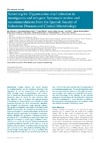Identificador persistente para citar o vincular este elemento:
https://accedacris.ulpgc.es/jspui/handle/10553/71853
| Campo DC | Valor | idioma |
|---|---|---|
| dc.contributor.author | Velasco, Maria | en_US |
| dc.contributor.author | Andres Gimeno-Feliu, Luis | en_US |
| dc.contributor.author | Molina, Israel | en_US |
| dc.contributor.author | Salas-Coronas, Joaquin | en_US |
| dc.contributor.author | Sola, Ivan | en_US |
| dc.contributor.author | Monge-Maillo, Begona | en_US |
| dc.contributor.author | Torrus-Tendero, Diego | en_US |
| dc.contributor.author | Cayla, Joan | en_US |
| dc.contributor.author | Nino de Guzman, Ena | en_US |
| dc.contributor.author | Pérez Arellano, José Luis | en_US |
| dc.contributor.author | Perez-Molina, Jose A. | en_US |
| dc.date.accessioned | 2020-04-30T09:38:09Z | - |
| dc.date.available | 2020-04-30T09:38:09Z | - |
| dc.date.issued | 2020 | en_US |
| dc.identifier.issn | 1560-7917 | en_US |
| dc.identifier.other | WoS | - |
| dc.identifier.uri | https://accedacris.ulpgc.es/handle/10553/71853 | - |
| dc.description.abstract | Background: Chagas disease has spread beyond its original borders on the American continent with migration. It can be transmitted from mother to child, through organ transplantation and transfusion of blood and blood products. It is necessary to determine when to screen for this infection. Aim: Our objective was to evaluate the appropriateness of screening for Trypanosoma cruzi infection in Latin American migrants and their descendants. Methods: We reviewed the literature using rigorous criteria. The quality of evidence was ranked according to the GRADE classification. An evidence to decision framework was adopted to provide information on the most relevant aspects necessary to formulate recommendations. Results: The 33 studies evaluated revealed a prevalence of T. cruzi infection among Latin American migrants in Europe of 6.08% (95% confidence interval (CI): 3.24-9.69; 28 studies). Vertical transmission occurred in three of 100 live births (95% CI: 1-6; 13 studies). The prevalence of cardiovascular disease was 19% (95% CI: 13-27; nine studies), including only 1% severe cardiac events (95% CI: 0-2; 11 studies). The overall quality of evidence was low because of risk of bias in the studies and considerable heterogeneity of the evaluated populations. The recommendations took into account economic studies on the value of screening strategies and studies on acceptability of screening and knowledge of the disease in the affected population. Conclusions: We identified five situations in which screening for T. cruzi infection is indicated. We recommend screening persons from endemic areas and children of mothers from these areas. | en_US |
| dc.language | eng | en_US |
| dc.relation.ispartof | Eurosurveillance | en_US |
| dc.source | Eurosurveillance [ISSN 1560-7917], v. 25 (8), p. 11-23, (Febrero 2020) | en_US |
| dc.subject | 3202 Epidemologia | en_US |
| dc.subject.other | Latin-American Migrants | en_US |
| dc.subject.other | Risk Blood-Donors | en_US |
| dc.subject.other | Chagas-Disease | en_US |
| dc.subject.other | Pregnant-Women | en_US |
| dc.subject.other | Congenital Transmission | en_US |
| dc.subject.other | Vertical Transmission | en_US |
| dc.subject.other | Economic-Evaluation | en_US |
| dc.subject.other | Randomized-Trial | en_US |
| dc.subject.other | Health Area | en_US |
| dc.subject.other | Prevalence | en_US |
| dc.title | Screening for Trypanosoma cruzi infection in immigrants and refugees: Systematic review and recommendations from the Spanish Society of Infectious Diseases and Clinical Microbiology | en_US |
| dc.type | info:eu-repo/semantics/review | en_US |
| dc.type | Article | en_US |
| dc.identifier.doi | 10.2807/1560-7917.ES.2020.25.8.1900393 | - |
| dc.identifier.isi | 000518026900003 | - |
| dc.description.lastpage | 23 | en_US |
| dc.identifier.issue | 8 | - |
| dc.description.firstpage | 11 | en_US |
| dc.relation.volume | 25 | en_US |
| dc.investigacion | Ciencias de la Salud | en_US |
| dc.type2 | Reseña | en_US |
| dc.contributor.daisngid | 17528668 | - |
| dc.contributor.daisngid | 30583040 | - |
| dc.contributor.daisngid | 32123333 | - |
| dc.contributor.daisngid | 35034465 | - |
| dc.contributor.daisngid | 34783831 | - |
| dc.contributor.daisngid | 978904 | - |
| dc.contributor.daisngid | 35035530 | - |
| dc.contributor.daisngid | 35036138 | - |
| dc.contributor.daisngid | 9237271 | - |
| dc.contributor.daisngid | 31842869 | - |
| dc.contributor.daisngid | 34941056 | - |
| dc.description.numberofpages | 13 | en_US |
| dc.utils.revision | Sí | en_US |
| dc.contributor.wosstandard | WOS:Velasco, M | - |
| dc.contributor.wosstandard | WOS:Gimeno-Feliu, LA | - |
| dc.contributor.wosstandard | WOS:Molina, I | - |
| dc.contributor.wosstandard | WOS:Salas-Coronas, J | - |
| dc.contributor.wosstandard | WOS:Sola, I | - |
| dc.contributor.wosstandard | WOS:Monge-Maillo, B | - |
| dc.contributor.wosstandard | WOS:Torrus-Tendero, D | - |
| dc.contributor.wosstandard | WOS:Cayla, J | - |
| dc.contributor.wosstandard | WOS:de Guzman, EN | - |
| dc.contributor.wosstandard | WOS:Arellano, JLP | - |
| dc.contributor.wosstandard | WOS:Perez-Molina, JA | - |
| dc.date.coverdate | Febrero 2020 | en_US |
| dc.identifier.ulpgc | Sí | es |
| dc.description.sjr | 2,766 | |
| dc.description.jcr | 6,307 | |
| dc.description.sjrq | Q1 | |
| dc.description.jcrq | Q1 | |
| dc.description.scie | SCIE | |
| item.grantfulltext | open | - |
| item.fulltext | Con texto completo | - |
| crisitem.author.dept | GIR IUIBS: Trypanosomosis, Resistencia a Antibióticos, Virología y Medicina Animal | - |
| crisitem.author.dept | IU de Investigaciones Biomédicas y Sanitarias | - |
| crisitem.author.dept | Departamento de Ciencias Médicas y Quirúrgicas | - |
| crisitem.author.orcid | 0000-0002-2936-8242 | - |
| crisitem.author.parentorg | IU de Investigaciones Biomédicas y Sanitarias | - |
| crisitem.author.fullName | Pérez Arellano, José Luis | - |
| Colección: | Reseña | |
Citas de WEB OF SCIENCETM
Citations
25
actualizado el 08-jun-2025
Visitas
68
actualizado el 09-dic-2023
Descargas
65
actualizado el 09-dic-2023
Google ScholarTM
Verifica
Altmetric
Comparte
Exporta metadatos
Los elementos en ULPGC accedaCRIS están protegidos por derechos de autor con todos los derechos reservados, a menos que se indique lo contrario.
